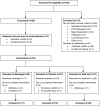Myofascial trigger point-focused head and neck massage for recurrent tension-type headache: a randomized, placebo-controlled clinical trial
- PMID: 25329141
- PMCID: PMC4286457
- DOI: 10.1097/AJP.0000000000000091
Myofascial trigger point-focused head and neck massage for recurrent tension-type headache: a randomized, placebo-controlled clinical trial
Abstract
Objective: Myofascial trigger points (MTrPs) are focal disruptions in the skeletal muscle that can refer pain to the head and reproduce the pain patterns of tension-type HA (TTH). The present study applied massage focused on MTrPs of patients with TTH in a placebo-controlled, clinical trial to assess efficacy on reducing headache (HA) pain.
Methods: Fifty-six patients with TTH were randomized to receive 12 massage or placebo (detuned ultrasound) sessions over 6 weeks, or to wait-list. Trigger point release massage focused on MTrPs in cervical musculature. HA pain (frequency, intensity, and duration) was recorded in a daily HA diary. Additional outcome measures included self-report of perceived clinical change in HA pain and pressure-pain threshold at MTrPs in the upper trapezius and suboccipital muscles.
Results: From diary recordings, group differences across time were detected in HA frequency (P=0.026), but not for intensity or duration. Post hoc analysis indicated that HA frequency decreased from baseline for both massage (P<0.0003) and placebo (P=0.013), but no difference was detected between massage and placebo. Patient report of perceived clinical change was greater reduction in HA pain for massage than placebo or wait-list groups (P=0.002). Pressure-pain threshold improved in all muscles tested for massage only (all P's<0.002).
Discussion: Two findings from this study are apparent: (1) MTrPs are important components in the treatment of TTH, and (2) TTH, like other chronic conditions, is responsive to placebo. Clinical trials on HA that do not include a placebo group are at risk for overestimating the specific contribution from the active intervention.
Conflict of interest statement
Figures



Comment in
-
Myofascial Trigger Point Release Massage Therapy Relieves Tension-Type Headaches.J Am Osteopath Assoc. 2016 Jan 1;116(1):55-6. doi: 10.7556/jaoa.2016.009. J Am Osteopath Assoc. 2016. PMID: 27270349 No abstract available.
-
Physiatry Reviews for Evidence in Practice Second-Order Peer Review: Does Massage Therapy Have Value in the Treatment for Tension Type Headache?Am J Phys Med Rehabil. 2018 Feb;97(2):141-142. doi: 10.1097/PHM.0000000000000833. Am J Phys Med Rehabil. 2018. PMID: 29342023 No abstract available.
References
-
- Crystal SC, Robbins MS. Epidemiology of tension-type headache. Curr Pain Headache Rep. 2010;14:449–54. - PubMed
-
- Schwartz BS, Stewart WF, Simon D, Lipton RB. Epidemiology of tension-type headache. JAMA. 1998;279:381–3. - PubMed
-
- Jensen R. Diagnosis, epidemiology, and impact of tension-type headache. Curr Pain Headache Rep. 2003;7:455–9. - PubMed
-
- Stovner L, Hagen K, Jensen R, Katsarava Z, Lipton R, Scher A, Steiner T, Zwart JA. The global burden of headache: a documentation of headache prevalence and disability worldwide. Cephalalgia. 2007;27:193–210. - PubMed
Publication types
MeSH terms
Grants and funding
LinkOut - more resources
Full Text Sources
Medical

